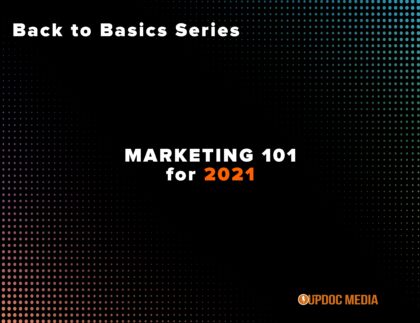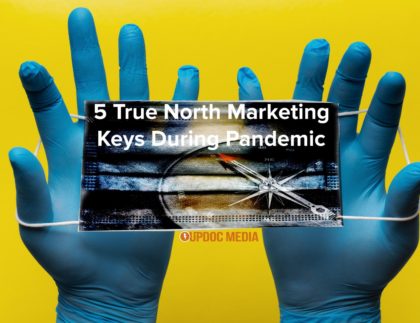
Like Physical Therapy, marketing is both an art and a science. The art is in the the why… the rationale and execution; the science is in the how and the what… it is found in the channels, platforms, touch points, budgets, and metrics behind each campaign.
AND… with so many marketing accelerators, boot camps, conferences, masterminds, webinars, etc. etc. etc. — it’s become a concerning wonder that perhaps “marketers” have become more skilled at marketing for marketing… rather than marketing for companies, organizations, brands, and clients.
This is where I believe the marketing mistakes begin. Just like in clinical care, if one becomes overly obsessed with the techniques or tactics of clinical care, it’s easy to forget about the overall approach in caring for the patient — the foreground of clinician interest then overshadows the context of providing care to the patient’s interest. In marketing, things are quite the same.
It can be truly easy to become too focused on a technique, a tool, a platform, or some new automation software update. While these are necessary and even welcome, they will prove little use without weaving them seamlessly together as a synergistic ecosystem.
Today’s article is all about….!
5 Marketing Mistakes That Will Stunt Your Growth
1. Lack of Consistency.
If you’ve looked into or have tried your hand in any type of marketing — be it traditional, digital, guerilla, influencer, etc. etc. etc. — you’ve probably noticed two important truths: (1) It’s easy to get started. (2) It’s truly a struggle to stay disciplined and consistent.
You’ve probably heard the phrase from yours truly, “Consistency is KEY” from my Game of Chess metaphor on marketing.

Strong marketing does not exist outside of high quality, audience engaging content. The act of marketing itself, the “most valuable chess piece,” exists as your strongest channel(s) in distributing that content, and more importantly, creating demand for your brand.
Brand.
Resonate with this word for a moment. B-R-A-N-D. Without a consistency, you have no brand. And, without a brand, audiences (new and old) will struggle to identify with your company’s unique value proposition.
“Consistency is key” across all things marketing. Your content must have a consistent brand voice. Your social media posts need to have a consistent brand image. Your marketing to sales funnel needs to have a consistent brand experience. Your actual delivery of products and services must be congruent with the tone and positioning across the consumer’s conversion journey so that they don’t feel like they are in the wrong place when they walk through the front doors.
All these elements add up in spectacular ways to those who are disciplined enough to master consistency; and, can result in some devastating losses to those who fail to establish the requisite systems in keeping consistent.
2. Failing to be CONSUMER Focused.
We’ve covered some of these topics in the past; but, like all great topics of discussion — it’s worth a rehash.
All too often, healthcare marketing efforts come from the clinician’s voice; a narrative from provider-to-provider as if to show-off or brag to each other about how “awesome we are.” Sadly, this is a terrible blunder that happens far more often than we care to share.
Marketing is creating demand. In order to create demand, you need to define who what segments of the available consumer are your target customers. I’d like to suggest in healthcare, there are two primary buyer typologies to be catered too: (A) the “patient,” which may extend to a health-fitness-wellness client; and, (B) top talent, in the form of recruiting, human resources, and talent acquisition/retention concerns.
FOR THE PATIENT: Let’s be honest. Most patients do not care if you have extra credentials or are the best clinician, ever. As healthcare consumers, we EXPECT the care to have a certain level of excellence and ALWAYS want the best. Objectively proving that you are the best doesn’t make you any more marketable than the next option. What WILL make you more marketable is becoming more relatable, accessible, and authentic to your community. Direct-To-Consumer Marketing focuses on a brand narrative to what your prospective patient can expect before, during, and after care. Setting these patient expectations not only sets up the patient for success, it also sets up your providers for positive patient encounters.
FOR THE PROSPECTIVE TEAM MEMBER: In a similar vein, your marketing efforts should be consistently (there it is, again!) making authentic connections with the developing professional, attracting top talent to stay in touch for when opportune moment may arise within the company. Specific to Physical Therapy, we suffer ~16% turnover, annually; the costs of which are fleshed out in the 2018 Physical Therapy Industry Prospectus. This is an incredible financial and operational burden to practices of any size and/or scale. So, in order to cater content to what top talent is looking for, you must first understand their motivation and drives. To this, we’ve got the 2018 survey results in a Talent Acquisition Report — to view this report, just [Click HERE]! You can also check out our classic case study: “Attracting and Keeping Top Talent.”
If you’re interested in reading more, you can also check out these two of our classic blog posts: “The Big 3, Part 3, Marketing” and “5 Website Flaws That Are Killing Your Clinic.”
3. Your Strategy Fails to Incorporate an Ecosystem Approach.
I’m going to say it now, and, I will probably say it again… and, again…. AND, AGAIN.
ONE-OFFs NEVER WORK.
They just don’t work! The number of practice managers, owners, partners, marketing directors, etc. who have complained to me that their digital advertisements failed to bring in any new patients… is nothing shy of staggering.
When you peel back the cause, it becomes painfully apparent that the advertisements were simply one-offs. A boosted blog post here, or, a sponsored video there, or even, an influencer article far over which-where.
The root problem here isn’t the platform or channel of choice. It’s the fact that the behaviors above describe a marketing approach that simply chases tactics around or tries out the newest thing but just one time. What is the latest tool? What is the latest buzz? Who has the most recent automation update? Like a cat following a laser pointer, chasing the shiniest new marketing object rarely leads to anything outside of a financial wash. More often than not, the consequence is your classic short term gain paired with the long term losses suffered from NOT investing in an fully encompassing marketing strategy.
Marketing fails when it is uni-dimensional, the same way clinical care largely fails if a provider only ever uses a singular intervention for all patient types.
You need the right provider with the right clinical approach for the right patient at the right time.
Marketing is no different. You want the right message for the right audience for the right action at the right time.
To do this, you MUST have an ecosystem approach. What do we mean by ecosystem? It means, you can’t just rely on one or two primary marketing channels. You DEFINITELY CANNOT rely upon word or mouth or physician referrals — and, just in case you missed it: A recent study showed a 50% drop-off of PCP referrals to Physical Therapists.
So… what comprises a minimally viable marketing ecosystem?
- A Discovery Channel — Example: A mobile optimized, SEO precise, website; organically searchable within the first few pages of results… ideally, within the top fold or first page.
- An Attraction Channel — Example: A Facebook business page with high levels of organic engagement; and, a multi-tiered advertising campaigns, targeting ideal buyer personas in parallel.
- A Conversion Channel — Example: A Facebook messenger bot that bifurcates for opt-ins and for direct calls to a designated clinical reception team, ready to close the sale.
The three above form the foundation of a true ecosystem. Need to read up on marketing? Check out 12 Marketing Articles You NEED To Read.
4. No Defined Budget.
It’s fact: Many healthcare companies do NOT have a defined marketing budget. A lack in defined funds to marketing also yields a lack of defined metrics.
THANKFULLY, it doesn’t require a multi-million dollar marketing and advertising budget to be successful or to even enjoy minimally reasonable ROI to a company’s marketing initiative. It DOES, however, typically require 20-40% of gross revenue for startups, 8-20% of gross revenue for growing entities rising to scale, and 5-8% of gross revenue for companies at scale to meaningfully create marketplace demand across an ecosystem approach [reference/read more…].
Now, does even 5-8% of gross revenue seem a bit high? Maybe… or, maybe it’d seem to be more normal if marketing is seen as the fuel for the vehicle of your business — the way many other industries, in fact, do. All too often, practices struggle for growth without ever investing in growth itself. We wrote up an article on this very topic in early 2016.
But… what about now? How should healthcare and health-tech companies budget out their marketing efforts for 2018?
- First: Check out this article on “5 Steps To Recharge Your Marketing Strategy” via the APTA Private Practice Section’s Impact Magazine.
- Second: Commit to a set marketing budget, beyond what you already have set aside as payroll et al for your marketing department. This means digging into your top line and identifying a specific number of dollars you’ll pull from your revenue stream to be dedicated for ads expenditures, public relations, customer relationship management platforms (CRM), Smart Automation Marketing (SAM), etc.
- Third: If you are so inclined… schedule a free strategy session with the UpDoc Team! At the very least, you’ll get a set of company recommendations, specific to YOU.
5. Failure To Establish A Tracking System.
The final point of failure that will stunt your company’s growth is failure to track your outcomes. It’s nearly silly to even mention this… except, it isn’t. In all honesty, it wasn’t actually that long ago that the healthcare market demanded for providers to actually track their outcomes. Similarly, it really hasn’t been that much of a window of time within recent digital marketing history that efforts could be reasonably and meaningfully measured.
Again… marketing is an art and science, just as it is for Physical Therapy practice. STILL, we can measure outcomes in a way that is significant to organizational growth and financial return.
Ergo, as in clinical practice, you can’t know if your interventions are working if you don’t measure them. And, you have to TRULY measure them with useful measures. It’s not just about range of motion; which is the marketing equivalent of lead source. You must track the entire conversion journey. HOW are consumers finding you? Becoming attracted to you? Converting as paying customers?
So… what specific touch points should you track?
- Lead source: How and/or where did they hear of you?
- Conversion journey: How, and/or, what steps along they way did they take in choosing you?
- Purchasing behavior: Why did they end up choosing you?
- Return on brand equity: Would they recommend you to a friend, a colleague, or family?
- Identifying brand ambassadors: Who will share the amazing experience they’ve had as a result of purchasing your company’s services and/or products?
Some Final Words
I hope that this article and the many posts linked in the content above is helpful to you, no matter where your walk may be. For the many of you reading this as students or developing professionals, these are business competencies you can take along your career path as well as to the practice settings you join. If you are in practice management or have an executive influence within your practice setting, we’d like to encourage you to help elevate the profession and growing into new markets. After all, the Physical Therapy profession boasts a mere 7-9% of the musculoskeletal market. Surely, we can do better. Surely, there is much to do in bringing our legacy to the next level and beyond.
As always, your communiqué is warmly welcome should you have any concerns, questions, comments, or if you have the desire to make your voice heard. AND, OF COURSE… if you wish to chat about building out an ecosystem for your practice, company, or organization — if even to simply rebrand… [Click Here. Let’s Get In Touch]!
Yours In Service,
—Ben Fung, DPT, MBA
Co-Founder, COO, UpDoc Media
Co-Founder, CFO, Recharge|HoCo-CrossFit
ben@devbox.updocmedia.com
C: 470-BEN-FUNG
Twitter: @DrBenFung
Snapchat: DrBenFung
Instagram: @DrBenFung










